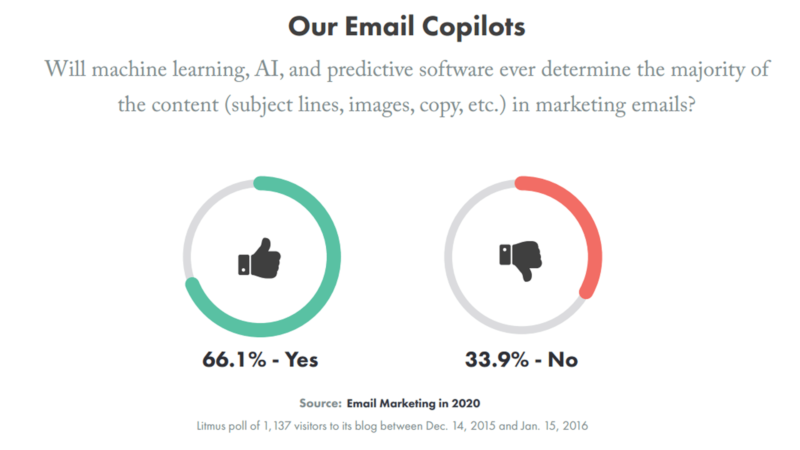Email marketers, meet your new cubicle mate: machine intelligence
Columnist Chad White takes a look at the future of machine learning and AI in email marketing, its limits, and why humans will still have a big role to play.
 In a few years, email copywriters may spend more time editing and approving copy than writing it, and email designers may not actually design “emails” at all. Why? Because of advancements in machine learning and automation.
In a few years, email copywriters may spend more time editing and approving copy than writing it, and email designers may not actually design “emails” at all. Why? Because of advancements in machine learning and automation.
Litmus (my employer) recently asked more than 1,100 marketers: “Will machine learning, AI, and predictive software ever determine the majority of the content (subject lines, images, copy, etc.) in marketing emails?”
The answer? Two-thirds of marketers welcome their machine co-workers — whether it’s begrudgingly or eagerly:

Machine learning, predictive analytics and other tools are already making an impact on how marketers generate email content. Intelligent software is currently contributing the most in the form of product and content suggestions for individual subscribers, but it’s also involved with subject line writing and other aspects of email marketing.
There’s little doubt that over time, machines will be even more actively involved than they are now.
Machine intelligence is well-suited to thrive in email marketing because the medium is:
- high-frequency;
- high-volume;
- data-rich; and
- one-to-one.
The role of machines in email marketing was one of the many subjects that came up in our “Email Marketing in 2020” report (email registration required), which examined what the channel would look like in the years ahead.
Tim Watson, founder of Zettasphere, and Morgan Stewart, CEO and co-founder of Trendline Interactive, were among the most optimistic about how intelligent software will guide future email marketing campaigns, primarily because the scale of one-to-one marketing is simply too great for humans to wrangle. Watson said in the report:
[blockquote]New paradigms are needed that allow marketers to create principle-based automation rather than the current prescriptive-based methods. Operating off these principles, machine intelligence will manage and control the messaging to each individual across channels, creating the truly integrated experiences that are currently talked about a lot but rarely delivered. [/blockquote]
To achieve this, Watson says that rather than modeling messaging sequences, marketers need to model their customers and have everything driven by that.
Stewart also sees the need to abandon the current prescriptive approaches to messaging:
[blockquote]In order to deliver a one-to-one experience, customer data and content must be completely divorced from one another and algorithms applied that identify which content should be delivered to which customer, and when. [/blockquote]
Ultimately, this leads to a new paradigm where marketers approve “content modules, not full creative, and sign off on targeting models, not customer segments,” he said.
In other words, marketers will no longer create emails — at least not in the traditional sense. Instead, they’ll create email content and define email audiences, and then software will use those raw materials to create one-to-one emails on a massive scale.
The limits of email marketing automation
All that said, people will still have a major role to play in email marketing for several critical reasons:
1. Machines are pretty horrible at creativity. That means companies will still need designers and graphic artists to create visuals and to set parameters around fonts, font sizes, color palettes and so on.
They’ll also need copywriters if they plan on using cultural references, humor or anything that’s not straightforward.
2. Marketers will need to supply AIs with the right data. Machine intelligence is only as smart as the data it’s given.
Marketers will have to decide how and when to ask for a variety of data points from their prospects and customers. Preference centers and progressive profiling efforts will likely become more important in the future because of the need for strong first-party data.
3. People will need to set the goals and parameters for their automation. Companies have different goals for different campaigns and separate goals for various audience segments, so your AI will need to know what exactly it’s trying to optimize at any given time.
Beyond those reasons, company goals also can shift because of competitive reasons, inventory levels, stock market influences and other factors.
4. Machines excel at logic, but human beings excel at being illogical. People are emotional, impulsive and unpredictable, and they make decisions that are counter to what might appear to be their best interests.
Marketers, not machines, will have the best chance of understanding people’s motivations and of connecting with their customers on an emotional level.
5. Because machines rely on historical performance for a lot of their “intuition,” they don’t handle shocks well. For instance, thanks to social media, cultural micro-shocks change the meaning, inferences and associations of particular words.
And macro-shocks like 9/11 and the Great Recession can quickly change the mindset and behaviors of your audience. Marketers will continue to have a strong hand in navigating these shocks.
All of this boils down to the fact that experimentation and A/B testing will be all the more vital to success in the years ahead — except marketers won’t just be testing designs, wording and timing. Marketers will spend an increasing amount of time testing logic and verifying that the machines are right — just so they don’t forget who the boss is.
Contributing authors are invited to create content for MarTech and are chosen for their expertise and contribution to the martech community. Our contributors work under the oversight of the editorial staff and contributions are checked for quality and relevance to our readers. MarTech is owned by Semrush. Contributor was not asked to make any direct or indirect mentions of Semrush. The opinions they express are their own.
Related stories
New on MarTech